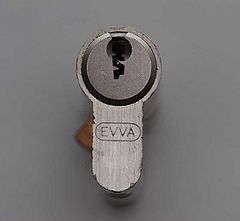EVVA DPI
EVVA DPI
| EVVA DPI | |
 | |
| Name | EVVA DPI |
|---|---|
| Manufacturer | EVVA |
| Lock Type | Cylinder |
| Lock Design | Slider, Sidebar |
| Year(s) Produced | 1995 |
| Security Rating(s) | EN 1303:2005 |
| Specifications | |
| # of Components | 5 or 6 |
| Component Type | Slider |
| Related Locks | |
| EVVA DPS/DPX
EVVA DPE | |
The EVVA DPI (Double Profile Integrated ) is a EN 1303:2005-rated dual sidebar lock made by EVVA. The DPI uses two sidebars; one controlled by five or six spring-biased sliders, and the other by the key profile. The six component version is marketed as the DPI-6. Unlike other locks in EVVA's Dual Profile series, newer models of the DPI cannot be bumped because they no longer use pin-tumblers. Older models are still vulnerable.
History
Add to me!
Principles of Operation
The DPI is a combination of two sidebars. The first sidebar is controlled by a set of five spring-biased sliders. Sliders provide picking resistance in the form of false cuts. Unlike traditional sidebars which align to the center, sidebar cuts must all align at the top of the sidebar.
The second sidebar is used for key profiling but is not completely passive. Instead, this sidebar is a combination of traditional key profiling with an active moving element in the center. When the plug is rotated, the moving element must be properly positioned or a trap pin at the top of the cylinder will fire and prevent further rotation or removal of the key.
The cylinder and plug have hardened steel rods to protect against forced entry techniques, namely drilling. (Carbide rods can also be provided upon request)[1]
Disassembly instructions
- Remove the cam and C-clip.
- Insert the key and turn the plug 30-45 degrees in either direction.
- Slowly withdraw the plug from the cylinder.
Notes
- The plug may be difficult to remove at any 90 degree orientation because of the trap pin; 45 degree angles are recommended.
- The trap pin is beveled so it cannot fall out when removing the plug.
Ratings
- EN 1303:2005 locking security category 6, lockpicking resistance category 2[1]
- EI 30, E 30
Vulnerabilities
The DPI may be vulnerable to one or more of the following:
- Lockpicking
- Impressioning
- Decoding
- Key bumping (pin-tumbler versions only)
Notes
- Older DPI models are pin-tumbler-based and can be bumped.
- The profile sidebar may be bypassed by filing down the key. The trap pin area of that sidebar must not be filed down.
Gallery
References
See also
- Sidebar
- EVVA
- EVVA DPS/DPX
- EVVA DPE







